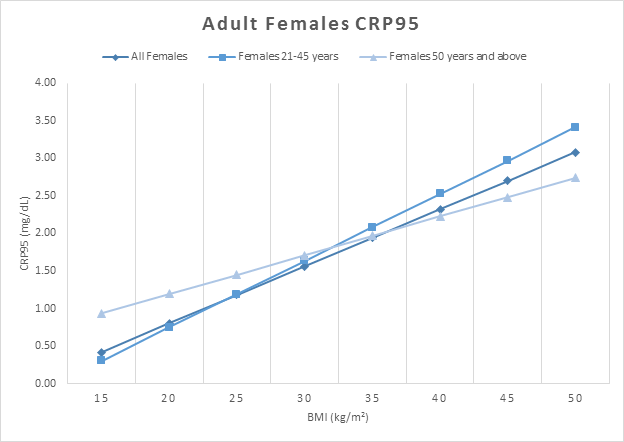Session Information
Date: Tuesday, November 7, 2017
Title: Epidemiology and Public Health Poster III: Rheumatic Disease Risk and Outcomes
Session Type: ACR Poster Session C
Session Time: 9:00AM-11:00AM
Background/Purpose:
C-reactive Protein (CRP) is an inflammatory marker commonly used to help aid in diagnosis, assess disease activity or monitor response to therapy. It is well established that many factors alter the serum CRP level, excluding infectious, malignancy, or rheumatologic causes. Obesity has been demonstrated to be a risk factor that contributes to elevated CRP levels. There is evidence that adiposity influences CRP levels and not vice versa (1). The proposed mechanism is that human adipose tissue expresses and releases the pro-inflammatory cytokine interleukin-6, inducing low-grade systemic inflammation in individuals with excess body fat (2).
The widely accepted reference range of CRP in healthy individuals is <1.0 mg/dL. The objective of our study was to quantify the association between obesity and CRP in order to establish an upper reference limit CRP for a given body mass index (BMI) in a healthy adult population.
Methods:
The NHANES (National Health and Nutrition Examination Survey) data from 2000 to 2010 was analyzed. Age was limited to 21 years and above to represent the adult population. BMI was limited to ≤50 kg/m2 and CRP limited to ≤5 mg/dL to exclude extreme values. The total number of analyzed subjects was 37303.
Quantile regression analysis was used to determine the median (CRP50) and 95th percentile CRP (CRP95) at various BMI levels. CRP95 was accepted as the upper reference limit of CRP.
Subgroup analysis was done comparing a younger population (21 to 45 years old) and older population (50 years old and above) and all analyses were based on gender.
Results:
Both CRP50 and CRP95 increase with increase in BMI.
The slope estimate of CRP95 was higher in females compared to males (0.0761 vs 0.0455 (P<0.001), respectively).
From these results we derived a simple calculation to approximate the CRP95, or reference upper limit of CRP, for a given BMI:
Males: CRP ≤ 1.0 + ( BMI-25)/25
Females: CRP ≤ 1.0 + (BMI-25)/12.5
Subgroup analyses showed that the younger female subgroup had the highest increase in CRP95 (slope estimate=0.089) and the older male group showed almost no increase in CRP95 with increase in BMI (slope estimate=0.002).
Conclusion:
Serum CRP levels increase with BMI increase in adults, and are higher in females than males at all elevated levels of BMI. BMI seems to influence the 95th percentile CRP of younger females most and older males least.
We propose a practical calculation that can predict the upper reference limit of CRP for a given BMI.
Reference
1. Int J Obes (Lond) 2011 Feb ; 35(2): 300–308
2. JAMA 1999 Dec 8;282(22):2131-5
To cite this abstract in AMA style:
Kim T, Ganocy SJ, Antonelli M, Einstadter D, Ballou S. Association of CRP with BMI in Males and Females [abstract]. Arthritis Rheumatol. 2017; 69 (suppl 10). https://acrabstracts.org/abstract/association-of-crp-with-bmi-in-males-and-females/. Accessed .« Back to 2017 ACR/ARHP Annual Meeting
ACR Meeting Abstracts - https://acrabstracts.org/abstract/association-of-crp-with-bmi-in-males-and-females/


